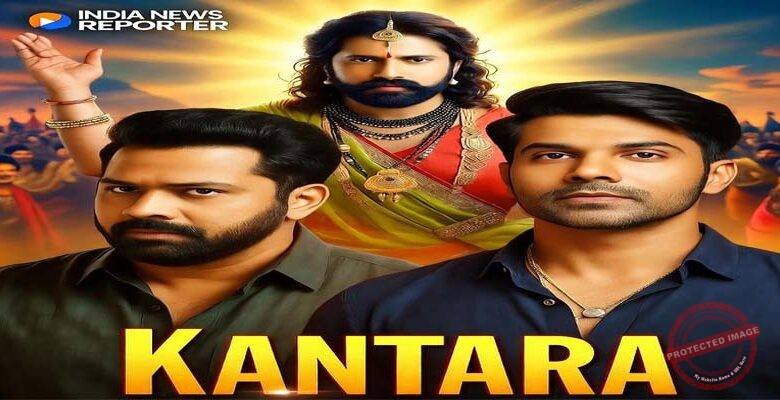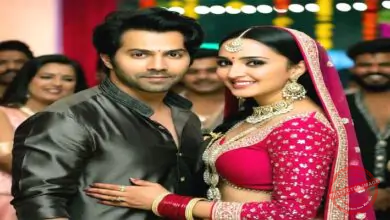Kantara Triumphs, Sunny Stumbles and AI Shadows Loom Over Indian Cinema

India News Reporter Entertainment Desk: In the ever-vibrant tapestry of Indian cinema, where dreams are scripted in silver reels and stardust, October 2025 has unfurled a rollercoaster of triumphs, tumbles, and tech-driven tremors. From the thunderous roar of Rishab Shetty’s Kantara: Chapter 1 storming past box-office milestones to the quiet fade of Varun Dhawan’s festive flick Sunny Sanskari Ki Tulsi Kumari, the industry is buzzing with narratives that blend cultural epics, rom-com romps, and the eerie specter of artificial intelligence. As Bollywood navigates a landscape reshaped by pan-Indian hits and digital disruptions, let’s dive into the latest headlines shaping the silver screen.
Kantara: Chapter 1 A Cultural Colossus Crosses ₹400 Crore, Eclipseing KGF Chapter 1
Rishab Shetty’s magnum opus Kantara: Chapter 1, the prequel to the 2022 blockbuster that captivated hearts with its raw portrayal of Karnataka’s Bhoota Kola folklore, has emerged as the undisputed box-office behemoth of 2025. Released amid high anticipation, the film has not only shattered expectations but also redefined the scope of regional cinema’s national appeal.
In a stunning feat, Kantara: Chapter 1 has surged past the ₹400 crore mark worldwide within weeks of its debut, eclipsing the lifetime earnings of Prashanth Neel’s KGF: Chapter 1 (₹250 crore). This milestone cements its position as the fourth highest-grossing Indian film of the year, edging out competitors like the animated spectacle Mahavatar Narsimha (₹300-325 crore). Shetty, who dons the dual hat of director and lead actor embodying the fierce deity Panjuru Daiva, attributes the success to an authentic fusion of mythology, action, and artistry.
What sets this chapter apart? The film’s production is a testament to collaborative genius, uniting artisans from across India – from Karnataka’s traditional mask-makers to Kerala’s master sculptors and Tamil Nadu’s intricate prop designers. A sprawling temple set, meticulously aged to depict decades of history, serves as the pulsating heart of the narrative. ‘This isn’t just a film; it’s a living homage to our roots,’ Shetty shared in a recent interview, his voice echoing the primal chants that have become synonymous with the franchise.
Critics hail it as a ‘pan-Indian prayer,’ blending high-octane sequences choreographed by international stunt coordinators with soul-stirring folk music by Ajaneesh Loknath. At the domestic front, it has raked in over ₹150 crore in India alone, with fans in far-flung locales like Dindigul dressing as the deity for screenings, turning theaters into impromptu festivals. As Kantara continues its rampage – projected to hit ₹500 crore by Diwali – it signals a seismic shift: South Indian epics are no longer regional whispers but national anthems.
Sunny Sanskari Ki Tulsi Kumari: Festive Fireworks Fizzle at the Box Office
While Kantara soars, not every Diwali darshan is sparkling. Varun Dhawan’s much-hyped rom-com Sunny Sanskari Ki Tulsi Kumari, directed by Shashank Khaitan and backed by Karan Johar’s Dharma Productions, has hit a sour note, limping to a mere ₹36.21 crore in its first six days. Billed as a grand family entertainer set against the riotous backdrop of a big fat Indian wedding, the film promised laughter, love, and lavish sets – starring Dhawan opposite the effervescent Janhvi Kapoor.
Yet, audiences have voiced disappointment over a predictable plotline and lackluster execution, with the narrative meandering through clichéd tropes of sanskari romance without the zing of predecessors like Humpty Sharma Ki Dulhania. Day 6 collections plummeted further, overshadowed by Kantara‘s unrelenting grip on screens. ‘Varun’s charm is intact, but the script needed more spice,’ noted trade analyst Ramesh Bala, pointing to a 20% drop on Monday.
Despite the setback, whispers of OTT redemption swirl, with Netflix eyeing early streaming rights. For Dhawan, fresh off action ventures, this return to rom-com roots serves as a reminder of Bollywood’s fickle fortunes where star power meets story, and sometimes, the latter wins.
In the wider October slate, other releases vie for attention: Ayushmann Khurrana’s quirky courtroom drama Thama (with Rashmika Mandanna and Nawazuddin Siddiqui) gears up for Diwali, promising a blend of humor and social commentary. Meanwhile, Anshuman Jha’s black comedy Lord Curzon Ki Haveli starring Rasika Dugal and Arjun Mathur – hit screens on October 10, delivering Hitchcockian thrills shot entirely in the UK.
AI’s Uninvited Reel: Bollywood Stars Battle Deepfake Deluge on YouTube
Amid the glamour, a digital shadow looms large. In a stark wake-up call for the industry, hundreds of AI-generated Bollywood videos amassing 16 million views have vanished from YouTube following a Reuters exposé on their uncanny resemblance to deepfakes fueling a high-profile legal battle. At the epicenter: a celebrity couple’s crusade to safeguard their likeness from unauthorized AI manipulations, echoing global concerns over consent in the age of generative tech.
One notorious channel, peddling ‘AI-generated Bollywood love stories’ with explicit undertones, was scrubbed entirely, its 259 videos viewed 16.5 million times now ghosts in the machine. YouTube confirmed the creator’s voluntary deletion, but the incident underscores India’s YouTube dominance (600 million users) and the platform’s role as Bollywood’s unofficial archive. Aishwarya Rai Bachchan, strutting at Paris Fashion Week just months ago, symbolizes the stars now fortifying digital defenses.
Industry voices, from directors to thespians, decry this as an existential threat. ‘AI isn’t creating stories; it’s stealing souls,’ quipped filmmaker Anurag Kashyap, who recently pivoted to regional cinema for creative respite. With tools like Midjourney and Stable Diffusion democratizing fakery, calls for robust IP laws grow louder. The Indian government, post the 71st National Film Awards (where Mohanlal clinched the Dadasaheb Phalke honor), has vowed stricter regulations, blending celebration with caution.
This AI skirmish arrives as Bollywood eyes Hollywood crossovers: Chad Stahelski (John Wick) is remaking Lakshya and Karan Johar’s Kill for international audiences, a nod to the industry’s global ambitions.
Glimpses from the Awards and Beyond: Mohanlal’s Legacy and Farhan’s Reflections
The 71st National Film Awards, held on September 23 at Vigyan Bhawan, New Delhi, underscored cinema’s societal pulse. President Droupadi Murmu lauded films awakening ‘society and the nation,’ spotlighting women-centric tales. Malayalam icon Mohanlal received the prestigious Dadasaheb Phalke Award, his five-decade odyssey celebrated by peers like Shah Rukh Khan (honored for Jawan). ‘Cinema isn’t just industry; it’s sensitivity,’ Murmu remarked, as tributes flowed for Waheeda Rehman.
Echoing nostalgia, Farhan Akhtar reflected on Dil Chahta Hai‘s 25th anniversary – turning 50 himself – crediting its cult status to meticulous planning and Excel Entertainment’s rise. ‘It gave me this life,’ he mused, inspiring a new wave of debuts at the 70th Filmfare Awards, from Alaya F to Rakul Preet Singh.
As October unfolds, with Dhadak 2 (Siddhant Chaturvedi and Triptii Dimri) teasing unconventional romance and Yash’s Toxic wrapping Mumbai shoots for a global spectacle, Indian cinema pulses with promise. From folklore to fakes, the reel world reminds us: in Bollywood, every frame is a fight for the future.
India News Reporter – Your window to the world of wonders, where entertainment meets enlightenment. Stay tuned for more.








